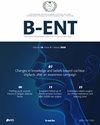求助PDF
{"title":"Comparison of the Effects of Nasopharyngeal Swab Methods on Anxiety Score During COVID-19 PCR Test","authors":"Mustafa Gulluev, N. Ata","doi":"10.5152/b-ent.2022.21446","DOIUrl":null,"url":null,"abstract":"Objective: Coronavirus disease-19 pandemic affected the whole world in 2020 and so far caused nearly 2 million deaths. The most commonly used method in the diagnosis of coronavirus disease-19 is to take swabs from specific areas in the upper respiratory tract, especially the nasopharynx. In this article, it was aimed to compare the effects of transoral/transnasal nasopharyngeal swab methods on anxiety score before and after the procedure. Method(s): This study was designed as a prospective randomized clinical trial. Hundred and four volunteers between the ages of 18-65 were included in the study, and volunteers were divided into 2 groups. Transoral method was applied to group-1 and transnasal method was applied to group-2. Visual Analog Scale scoring was performed to measure the anxiety/pain/general discomfort levels of the participants before and after the procedure. Result(s): In this study, 50 volunteers from the transoral group and the rest 54 volunteers from the transnasal group, a total of 104 individuals were included. Before the procedure, no statistically significant difference in anxiety levels was observed between the groups. However, anxiety, pain, and general discomfort levels during the procedure were found to be lower in group 1. Conclusion(s): In the light of the results of our trial, we suggest that the transoral nasopharyngeal swab method can be a better alternative in selected patient groups. The prime advantage of this procedure is that it causes less pain and general discomfort. We think that many complications encountered in the transnasal method can be overcome by the transoral method. Copyright © 2022 B-ENT. All rights reserved.","PeriodicalId":54251,"journal":{"name":"B-Ent","volume":" ","pages":""},"PeriodicalIF":0.2000,"publicationDate":"2022-05-20","publicationTypes":"Journal Article","fieldsOfStudy":null,"isOpenAccess":false,"openAccessPdf":"","citationCount":"0","resultStr":null,"platform":"Semanticscholar","paperid":null,"PeriodicalName":"B-Ent","FirstCategoryId":"3","ListUrlMain":"https://doi.org/10.5152/b-ent.2022.21446","RegionNum":4,"RegionCategory":"医学","ArticlePicture":[],"TitleCN":null,"AbstractTextCN":null,"PMCID":null,"EPubDate":"","PubModel":"","JCR":"Q3","JCRName":"Medicine","Score":null,"Total":0}
引用次数: 0
引用
批量引用
COVID-19 PCR检测中鼻咽拭子方法对焦虑评分影响的比较
目的:2020年冠状病毒病-19大流行影响全球,迄今已造成近200万人死亡。冠状病毒病-19的诊断最常用的方法是在上呼吸道的特定区域,特别是鼻咽部取拭子。在本文中,目的是比较经口/经鼻鼻咽拭子方法对手术前后焦虑评分的影响。方法:本研究设计为前瞻性随机临床试验。104名年龄在18-65岁之间的志愿者参与了这项研究,志愿者被分为两组。1组采用经口法,2组采用经鼻法。采用视觉模拟量表评分来测量参与者在手术前后的焦虑/疼痛/一般不适水平。结果:本研究共纳入经口组50人,经鼻组54人,共104人。在手术前,两组之间的焦虑水平没有统计学上的显著差异。然而,在手术过程中,第一组的焦虑、疼痛和一般不适水平较低。结论:根据我们的试验结果,我们建议经口鼻咽拭子法在选定的患者群体中是一种更好的选择。这种手术的主要优点是疼痛和全身不适较少。我们认为经鼻入路的许多并发症都可以通过经口入路来克服。版权所有©2022 B-ENT。版权所有。
本文章由计算机程序翻译,如有差异,请以英文原文为准。


